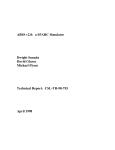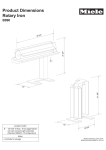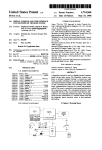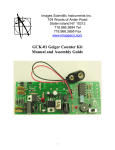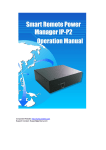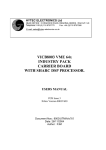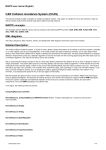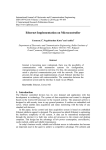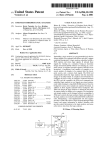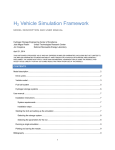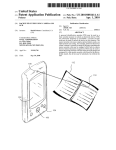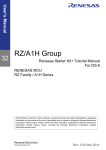Download The Avalanche Myrinet Simulation Package | User Manual for V2.0 |*
Transcript
The Avalanche Myrinet Simulation Package | User Manual for V2.0 | Chen-Chi Kuo, John B. Carter fchenchi, [email protected] WWW: http://www.cs.utah.edu/projects/avalanche UUCS-96-010 Department of Computer Science University of Utah, Salt Lake City, UT 84112 September 24, 1996 Abstract This is a user manual for Version 2.0 of the Myrinet simulation package. Users of the V2.0 package can specify arbitrary network topologies composed of Myrinet switches with dierent number of ports. For example, 4-port and 32-port switches can be used in a single system. Because the V2.0 model supports arbitrary topologies, simple X-then-Y source routing is no longer sucient to model the required routing. Thus, users of the V2.0 package must specify the routing table themselves. In addition, to track improvements to the circuit technologies used in the Myrinet switches, the clock rate, latency and bandwidth have been parameterized. Users can change the parameters in order to meet their simulation needs. In the manual, the example-driven method is used to explain how to build your own Myrinet switch systems. This work was supported by the Space and Naval Warfare Systems Command (SPAWAR) and Advanced Research Projects Agency (ARPA), Communication and Memory Architectures for Scalable Parallel Computing, ARPA order #B990 under SPAWAR contract #N00039-95-C-0018 1 Contents 1 Introduction 2 Conguration Files 2.1 System Parameters File 2.2 Topology File : : : : : : 2.3 Routing Table File : : : 3 3 : : : : : : : : : : : : : : : : : : : : : : : : : : : : : : : : : : : : : : : : : : : : : : : : : : : : : : : : : : : : : : : : : : : : : : : : : : : : : : : : : : : : : : : : : : : : : : : : : : : : : : 3 Interfaces with the Upper Level Simulation Codes 4 7 7 8 1 Introduction This is the user manual for the congurable Myrinet1]1 simulation package that has been developed for the Avalanche project at University of Utah. This package requires the use of the PAINT architecture simulator2], which was evolved as part of the Avalanche eort from the University of Rochester's MINT simulator3]. To use this Myrinet simulation package, you must link with the PAINT library and use PAINT to drive the simulation itself.2 Please refer to the Avalanched project home page at http://www.cs.utah.edu/projects/avalanche for more details about the PAINT simulation and to acquire a copy of PAINT. Version 2.0 of the Myrinet simulation package was designed to allow a high degree of congurability of the modeled network. Version 1.0 modeled only simple square mesh topologies with 4-port switches, and users could specify only a limited number of switch parameters. As Myricom released larger and faster versions of their Myrinet switches, the V1.0 simulation model became obsolete. Users of the V2.0 package can specify arbitrary network topologies composed of Myrinet switches with dierent number of ports. For example, 4-port and 32-port switches can be used in a single system. Because the V2.0 model supports arbitrary topologies, simple X-then-Y source routing is no longer sucient to model the required routing. Thus, users of the V2.0 package must specify the routing table themselves, as described in Section 2. In addition, to track improvements to the circuit technologies used in the Myrinet switches, the clock rate, latency and bandwidth have been parameterized. Users can change the parameters in order to meet their simulation needs. The remainder of this user manual is organized as follows. In Section 2, the formats of the system conguration les are explained through a series of examples. Section 3 describes the interface between the Myrinet simulation package with PAINT, so that users can integrate their Myrinet network model into their PAINT architecture model. 2 Conguration Files Users of this package must provide three conguration les: a system parameter le that describes the performance parameters of the switches and links in the system, as well as a small number of global parameters, a network topology le that describes how the switches in the system are interconnected (i.e., what ports are connected to what other ports), and a network routing le the describes how to route from every processor to every other processor. The names of these parameter les can be specied in the PAINT command line using the -k, -t, and -r ags. For example, sim -n 16 -s 0x1800000 ;; -k sle -t tle -r rle barnes <input indicates that the system parameter le is called sfile, the topology le is called tfile, and the routing le is called rfile. Myrinet is a trademark of Myricom, Inc. For detailed information on Myrinet technology, see the Myricom home page at http://www.myricom.com. 2 PAINT is designed to model HP PA-RISC based multiprocessors, while MINT is designed to model MIPS-based multiprocessors. Although this package requires the use of PAINT, a port to the MINT system should be feasible with a limited amount of eort. If you perform this port, please send it back to us for inclusion in our release for others to use, and we will (of course) give you full credit for the port. 1 The required format of the three conguration les are explained in Sections 2.1 through 2.3 using the example topologies illustrated in Figures 1 and 2. Figure 1 illustrates a simple mesh topology composed of four and eight node switches, while Figure 2 illustrates a chordal ring topology composed of only four-node switches. 2.1 System Parameters File The System Parameters File species the conguration of the Myrinet switches in the system. An example is given below, with comments to explain the meanings of each parameter: # Simple Mesh System Parameters File # Total number of the processors in the system numOfProcessor 16 # Maximum number of ports on any single switch in the system maxNumOfPorts 8 # Total number of switches in the system numOfSwitch 7 # Link propagation delay, in cycles where 1 cycle == 10 ns propDelay 4 # Time to perform taxi translation and cross bar setup # for different switch sizes, measured in system cycles fallThruDelay4 26 fallThruDelay8 27 fallThruDelay16 30 fallThruDelay32 35 # Ratio between CPU and Myrinet switch clock rates # For example, if the processor speed is 100MHz and the modeled # Myrinet system clocks at 50MHz, the SpeedFactor is 2 SpeedFactor 2 # Myrinet switch slack buffer sizes (see Myrinet technical specs # for discussion of the kg, h, and ks values in the buffer) buffer_kg 32 buffer_h 16 buffer_ks 32 P0 P1 P2 P3 0 0 0 3 7 3 P15 S0 2 3 1 S1 1 2 0 2 1 S4 6 0 3 P14 S2 S3 1 2 P4 P5 1 3 2 5 0 4 1 0 7 1 7 P13 P6 2 S5 6 2 S6 6 P7 P12 3 5 4 P11 3 5 P10 4 P9 Figure 1: Example Topology: Simple Mesh P8 P0 P1 0 0 3 S0 3 1 2 S1 2 1 3 P7 1 0 S7 3 2 0 0 P2 1 2 1 P6 S2 2 2 S6 1 3 1 2 S5 0 3 2 1 3 S4 0 P5 P4 Figure 2: Example Topology: Chordal Ring 3 S3 0 P3 2.2 Topology File The topology le species the interconnections between individual switches in the system. It is used to dene the overall system topology. The following example le is the topology specication for the simple mesh in Figure 1. The topology le consists of one line per switch that designates where each of that switch's ports are connected (either to ports on other switches or to processors). Each line should have one entry for each port (i.e., the topology entry for a four-port switch must have four entries, while that for an eight-port switch must have eight). # Simple Mesh Topology File # Some definitions: # S0.1 means port 1 of switch number 0 # P0 means processor number 0 # D means dangling line S0: P0 S1.3 S2.0 P15 # Meaning: Port 0 of Switch 0 is connected to Processor 0 # Port 1 of Switch 0 is connected to Port 3 of Switch 1 # Port 2 of Switch 0 is connected to Port 0 of Switch 2 # Port 3 of Switch 0 is connected to Processor 15 S1: P1 S4.7 S3.0 S0.1 S2: S0.2 S3.3 S5.0 P14 S3: S1.2 S4.6 S5.1 S2.1 S4: P2 P3 P4 P5 S6.1 S6.0 S3.1 S1.1 S5: S2.2 S3.2 S6.7 S6.6 P10 p11 P12 S6: S4.5 S4.4 P6 P9 S5.3 S5.2 P7 P8 P13 The following example le is the topology specication for the chordal ring. # Chordal Ring Topology File S0: P0 S1.3 S3.2 S7.1 S1: P1 S2.3 S6.2 S0.1 S2: P2 S3.3 S5.2 S1.1 S3: P3 S4.3 S0.2 S2.1 S4: P4 S5.3 S7.2 S3.1 S5: P5 S6.3 S2.2 S4.1 S6: P6 S7.3 S1.2 S5.1 S7: P7 S0.3 S4.2 S6.1 2.3 Routing Table File Myrinet technology uses a static source routing mechanism. For simple mesh topologies composed of symmetric switches, a simple X-then-Y routing mechanism suces to route packets between input and output ports. However, because the V2.0 simulation package supports arbitrary network topologies and heterogenous switch sizes, X-then-Y routing is no longer sucient. Users must specify the static source routing tables explicitly to specify to the simulation how to compose the packet headers. A complete routing table le must include N N routing directions in an N processor system, one entry for each processor pair. Note that the routing need not be symmetric, meaning that packets from port X to port Y can take a dierent path than packets from port Y to port X. A partial sample routing table is given below. For space purposes, only the routes from one processor are given. Please refer to the simulation package itself for a complete example. The syntax of the routing le is as follows. For each processor pair, there must be one line specifying the order of switch output ports that a message traveling from the source to the destination must take. Port numbers are designated via a single character, ranging from 0-9 (for the rst ten ports) and then a-z (for the next 26 ports). For the V2.0 product, this results in a maximum switch size of 36 ports (or, realistically, 32 ports). In the example routing table below, for Processor 0 (P0) to send a packet to Processor 8 (P8), the packet will go through port 1 of S0, port 1 of S1, port 4 of S4, and nally port 4 of S6. This route is directed by the entry in the routing table P0 P8 with the sequence 1144. #Simple Mesh Routing Table File #sender receiver portnumber-sequences p0 p0 0 p0 p1 10 p0 p2 110 p0 p3 111 p0 p4 112 p0 p5 113 p0 p6 1142 p0 p7 1143 p0 p8 1144 p0 p9 1145 p0 p10 224 p0 p11 225 p0 p12 226 p0 p13 227 p0 p14 23 p0 p15 3 3 Interfaces with the Upper Level Simulation Codes Traditional PAINT architecture simulations consist of models for the CPU, cache controller, directory controller (for scalable DSM models), network interface, system bus, and other components. This Myrinet simulation package provides a portion of the router interface to create source-routing headers, route packets between nodes, model the network delays due to internal buering con- straints, etc. It does not, however, model input or output buering within a node (i.e., between the system bus and the network device). This level of buering must be modeled in the architecture simulation. The network simulation package models packet delivery and ow control at a cycle-by-cycle level of precision. To inject packets into the Myrinet fabric, the architecture simulation should invoke the Send function, which has the following type signature: Send(task ptr ptask, int src, int dest, int payload, void *msg addr, int info size, void *usr ptr, int do mem costs) The meaning of the parameters is as follows: ptask: the PAINT task that will be scheduled by the Myrinet simulation after the last it of the current packet is injected into the interconnect. At that point, the architecture simulation can issue another Send to ship the next packet. If other pieces of the simulation need to respond to the event of a packet transmission completing, users of this package must signal this event within the ptask routine. src: the processor id of the sending processor dest: the processor id of the destination processor payload: msg addr: the length of the user message body in bytes the memory address of the user message body, used to perform DMA transfers info size: length of the user message header in bytes usr ptr: an arbitrary pointer to be used by the communicating peers of the upper level simulation, which can be to pass information useful for controlling the simulation do mem costs: a ag to indicate if this Send call needs to DMA the packet data from the memory, which may cost some delay. A user-dene function Memory read, which is explained below, will be invoked when do mem costs is set. If the do mem costs is set, the function Memory read, dened by the users, will be invoked in order to simulate the delay caused by DMAing the packet data from the memory.The type signature of the Memory read function is as follows: Memory read(task ptr ptask, int src, void *msg addr, int payload) The meaning of the parameters is as follows: ptask: the PAINT task that MUST be scheduled in the Memory read, so the Myrinet simulation can nish shipping this packet. src: the processor id of the sending processor msg addr: payload: the memory address of the user message body, used to perform DMA transfers the length of the user message body in bytes Once the packet arrives at the destination processor, the Receive will be invoked by the Myrinet simulation. Users of this package must implement this Receive function. When the upper level simulation has consumed the packet, it MUST schedule the ptask or the Myrinet simulation will not deliver more packets. The type signature of the Receive function is as follows: Receive(task ptr ptask, int src, int dest, int payload, void *msg addr, int info size, void *usr ptr) The parameters of Receive are the same as the parameters in Send. References 1] N.J. Boden, D. Cohen, R.E. Felderman, A.E. Kulawik, C.L. Seitz, J.N. Seizovic, and W.-K. Su. Myrinet { A gigabit-per-second local-area network. IEEE MICRO, 15(February):29{36, February 1995. 2] L.B. Stoller, R. Kuramkote, and M.R. Swanson. PAINT- PA instruction set interpreter. Technical report, University of Utah - Computer Science Department, March 1996. Also available via WWW under http://www.cs.utah.edu/projects/avalanche/paint.ps. 3] J.E. Veenstra and R.J. Fowler. Mint: A front end for ecient simulation of shared-memory multiprocessors. In MASCOTS 1994, January 1994.















